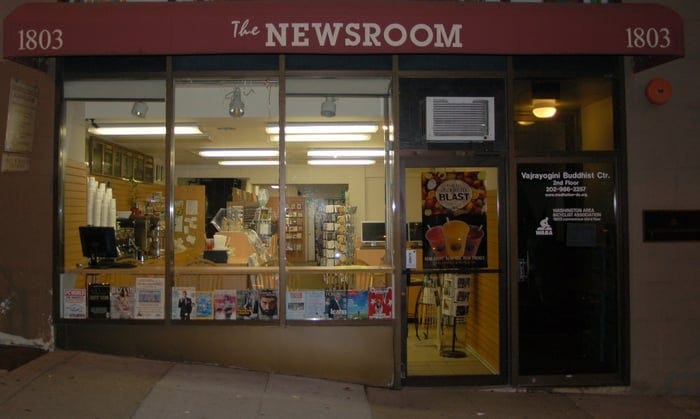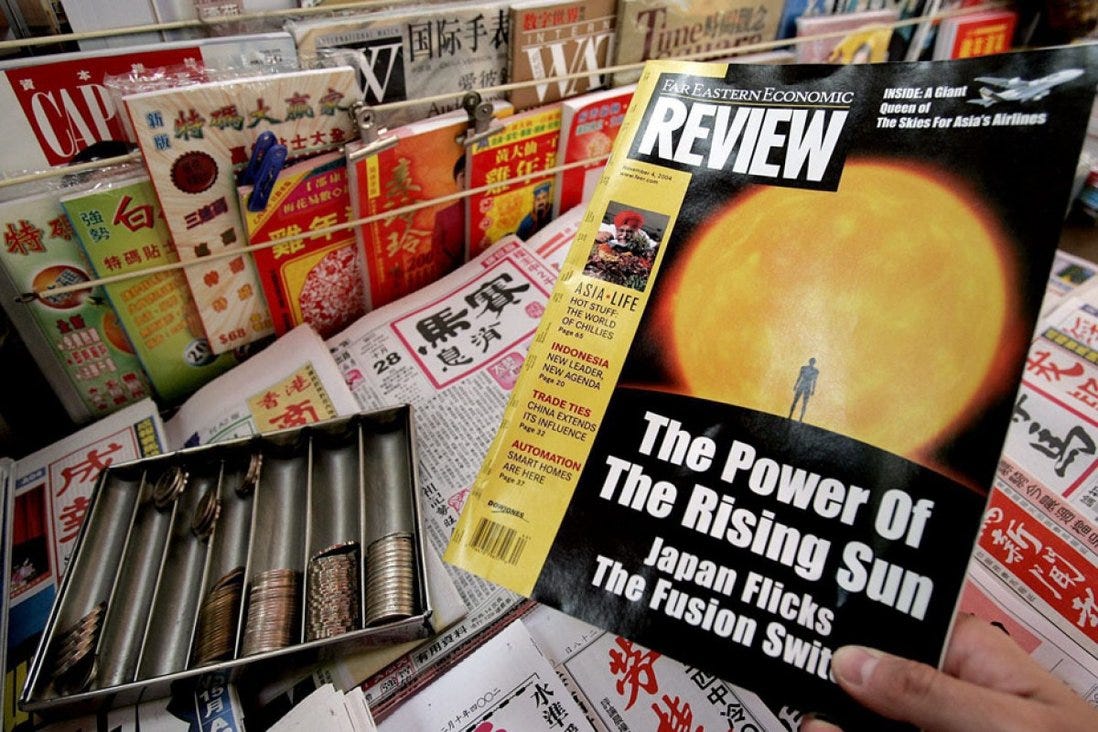The Slow, Sad Death of Print
Print newspapers - the "daily miracle" - are in terminal decline. Why we should hope they stay alive, and why the real miracle may be if they are still around two decades from now
Every day, three dying relics land on my doorstep with a thud. I wish they were not dying, and I will stand with them as they continue to breathe, but the writing is on the wall: print newspapers are in sad, terminal decline.
Here in the United States, print newspapers may be on their last legs. Over the past decade and a half, one in five US newspapers have shut down. Print circulation is at its lowest in 80 years.
In 1984, print circulation hit 63.3 million in the United States. Today, it stands at under 30 million. The New York Times and the Washington Post have both seen print circulation drops of more than 70% over the last decade and the Wall Street Journal - the most widely circulated U.S paper - has dropped to below a million a copies.
The news is not much better outside the United States. In Japan, where print publications can still command whopping circulation numbers, more readers are migrating online. Yes, Yomiuri Shimbun remains the most widely circulated newspaper in the world with nearly 8 million daily copies in print, but it, too, is declining in numbers. Even a staunch bastion of print dailies - India — has been hit hard by the rise of online media. The Covid-19 pandemic has delivered another major body blow to the India print industry.
The decline of print newspapers has been a slow drip, rather than a tsunami. In Ernest Hemingway’s novel, The Sun Also Rises, a lead character was asked how he went bankrupt. He responded: “It happened gradually, and then suddenly.”
Is that how print newspapers will end? Will we wake up one day a decade from now to hear that the New York Times or the Financial Times or the Hindustan Times has -- all of a sudden -- suspended its print edition due to declining circulation? Not a single US paper circulates more than a million copies today, according to latest data. This is not a growth industry.
But I’m holding out, even if I’m a dwindling minority. In addition to the three papers that land on my doorstep -- the Financial Times, the Wall Street Journal, and my local paper, the Washington Post -- I also receive the Nikkei Asia weekly print edition and a few travel magazines. I also buy specialty magazines from newsstands. This week, I bought African Business, New African and Monocle.
I bought them from The Newsroom, a Washington-DC establishment long past its hey-dey. Its new owner is making a valiant effort to stay afloat. In addition to selling newspapers and magazines from around the world, the store now also advertises shoe repairs in the back. I plan to get my soles re-done there next week.
This is where we are, but I wish it were not so.
I began thinking more about the state of print newspapers recently when I spotted a colleague wearing a jacket with the International Herald Tribune logo on it. When I saw that, my mind wandered to Paris, late 1980s, and my favorite news kiosk. It was not quite biting into a madeleine, but I had my own Proustian moment. It got me to think about the slow, sad decline of print newspapers and magazines, happening before our eyes, but also my own excited discovery of global print media.
I remember that news kiosk in Paris vividly. My family made a visit to the French capital in the late 1980s, when I was still in high school. I would visit the kiosk every day to flip through glossy French and Italian magazines, marvel at the dozens of newspapers on display, and buy the International Herald Tribune. I would proudly tuck the paper under my arm - feeling cosmopolitan and “in-the-know” - and find a nearby bench and read the global daily.
Up until that time, my newspaper of choice was our local daily, the Washington Post and, to be honest, the sports pages captured most of my reading attention. I had never seen such a global news kiosk, and I was hooked - and remain so. Of course, the Herald Tribune is no more. It shut its doors in 2013, and it remains a part of the collective nostalgia of many.
Sadanand Dhume, the astute South Asia columnist for the Wall Street Journal, told me that he remembers devouring day old copies of the Herald Tribune that his father would bring home from the Foreign Ministry offices in Delhi in the late 1980s. Dhume is a veteran of the Far Eastern Economic Review (FEER), another venerable print magazine that no longer exists. Born in Hong Kong in 1946, FEER was a breeding ground for some of Asia’s leading journalists and today’s political elites. Former Pakistani ambassador to the U.S, Husain Haqqani, is a veteran of the Review, where he covered Afghanistan and Pakistan.
The magazine fell successively under the ownership of Dow Jones and then Rupert Murdoch’s News Corp. Ultimately, News Corp. pulled the plug in 2009, though Dow Jones had gutted the publication earlier. A 2009 report in a Singapore publication noted that “the announcement marks the denouement of what observers and former staffers said had been a gradual decline in the fortunes of one of the great titles in Asian journalism, once considered essential reading for the region’s intelligentsia.”
A few years earlier, in 2001, another major Asian publication, Asiaweek, folded after a quarter century. In the Middle East region, the business print publication that occupied a similar place was Middle East Economic Digest (MEED). The publication continues to thrive online, but the regular print edition has morphed into a monthly, MEED Business Review. I’m glad to see it still alive and well.
The news kiosk, too, is in terminal decline. My friend Faraj Saghri, an avid news reader and newsstand kiosk-ophile who has had a distinguished three decade career in investment banking at JP Morgan, told me that he, too, misses the kiosk. He described it as the “place to plug into the world.” In much the same way that we search for Wi-Fi connections when we go somewhere new, Saghri saw the news kiosk of yore as the “Wi-Fi connection of our times.” It’s a great way to put it.
But I do not make this argument about print simply out of nostalgia or lament, but rather because I think print should still play a prominent role in our news consumption. There is gathering evidence that reading comprehension rises when reading complex texts in print rather than digitally. And what could be more complex than our news environment today?
A smart piece by Kerry Benson that looks at the evidence notes: “Turns out print is easier to comprehend than digital text.” Benson quotes Anne Mangen, a literacy professor at the University of Stavanger in Norway, who says: “[Print reading] is kind of like meditation — focusing our attention on something still. And it’s a whole different kind of immersion than responding to [digital] stimuli. I think it’s healthy for us as human beings to sit down with something that doesn’t move, ping, or call on our attention.”
She quoted Lauren Singer Trakhman, who studies reading comprehension at the University of Maryland, College Park, who said: “We read digital [text] more quickly, [so] we think we must understand it better. It’s one of the best parts of our digital world — everything is at our fingertips and we can get the headlines in a second — but it may also be one of the pitfalls. Everything’s so quick and accessible that we may not be truly digesting [what we read] anymore.”
Benson concludes by saying “complicated texts are best read in print, especially to retain the details.” Similar research for children shows that reading comprehension drops by as much as 30% when reading on screen.
One of the great Middle East correspondents of the modern era, Nora Boustany, had this to say about the world of print, when I reached out to her:
“Nothing beats the hard copy experience and sensation of leafing through a publication and revisiting the start of an article or the smell of fresh print! When radios came around, everyone predicted the death of newspapers. When TV came around, everyone thought it was all over for the airwaves and the ‘wireless’ as my grandmother called it. Laptops have made a huge dent in the size of the audiences devoted to all its predecessors, but none of them have really gone away.”
“I think it is phenomenal to be able to read anything from anywhere in the world online. But for those of us who were nurtured on the excitement of holding a smooth newspaper up to see what has happened, that first hand contact with the old medium will always be part of us!” Boustany makes a great point. One new medium does not mean the death of an old medium.
I often ask students both at the undergrad and graduate level how many them of read print newspapers? Quizzical stares ensue. When they see I’m serious, very few hands go up. Once, when I looked crestfallen by zero hands raised, one student tried to cheer me up, by saying: “I was on an international flight recently and they gave out newspapers and I took one.” Thanks, I guess.
These are smart young women and men, often well-informed of current events. These digital natives are just not getting their information from print newspapers. Fine, but I ask a similar question in executive education seminars among mid-career and senior professionals, essentially people of my own generation and older, with broadly similar results. They don’t give me quizzical stares, but still only a few sheepish hands go up when I ask the question.
“I might read USA Today or the Wall Street Journal when I’m staying in a hotel and they’re giving it away for free,” one mid-career pro said, but “otherwise, reading papers are just too inefficient.” Again, these are talented, successful professionals, but reading print newspapers are just not their thing.
I’m no Luddite. I also subscribe digitally to Bloomberg, Quartz, the South China Morning Post, and several other online publications. As you also know, we at Emerging World publish a round-up of top stories from the global media. We clearly cite and hyperlink, even if there is a paywall. Maybe that story we highlighted will encourage you to buy a subscription. That’s good. That’s supporting journalism.
When we highlight stories from global media you may not have heard of, it’s because we found the story interesting and thought you might too, but if it also serves to drive traffic to a news site in Tashkent or Buenos Aires, that’s an added bonus for us. If we can add eyeballs to other publications, that’s a win for journalism.
Ok, I get the multiple ironies here: a writer on an online publication is urging people currently reading this article on a digital device to still read print newspapers. This same writer sends you a daily emerging markets report culled from the digital editions of global media? Further irony: some are suggesting that Substack, this online medium, threatens newspapers by siphoning off reader’s attention and dollars.
To the latter charge re: Substack, I think that’s way overplayed. Really? Am I, a single writer exploring our emerging world of geopolitics and economics and business, ever going to be able to challenge Bloomberg or the Financial Times? Not a chance, but Substack writers can add to the global canvas of news, opinion, and analysis that makes up your daily diet.
I was immensely gratified by the reaction to my most recent column, Globalization in a Needle, that spread far and wide thanks to online and social media. I also recently received a kind note from someone on the other side of the world who had read my column on K-Pop and the new globalization of entertainment, and people still reach out to me for the column I wrote on Why Travel Matters. This would not be possible without online media.
But as Whitman wrote: “I am large. I contain multitudes.” You, dear reader, contain multitudes, and print publications should, in my humble opinion, remain part of our multitudes. I simply don’t see a contradiction in reading a print daily, scrolling newspapers on your laptop, and subscribing to a Substack newsletter. What I see is a cornucopia of choice.
One of my first newspaper bosses, the former Washington bureau chief of the Financial Times, Jurek Martin, told me this week that, he, too worries about the fate of newspapers. He, too, receives three print dailies a day and describes that moment when he makes a cup of tea, gathers the papers, and takes them to his bedroom for about an hour and half of reading as the best part of his day. “I feel like I know everything I need to know to start my day,” he told me.
But Martin was not optimistic about the fate of print dailies? “They may not be around much twenty years from now,” he said.
So, are these newspapers that land on my doorstep dying relics or still the “daily miracle” of yore? I still consider the print newspaper a daily miracle given the complexity of reporting, writing, editing, photographing, designing, printing, and distributing the whole thing in less than twenty four hours -- and then turning it around and doing it again, day after day.
But I’m beginning to think that the real miracle will be if they are still with us twenty years from now.
For a daily round-up of the top stories shaping emerging markets, occasional thought leader interviews, and this weekly column…








Yes, print publications should remain part of our multitudes... Fantastic piece.... Thank you, Afshin...